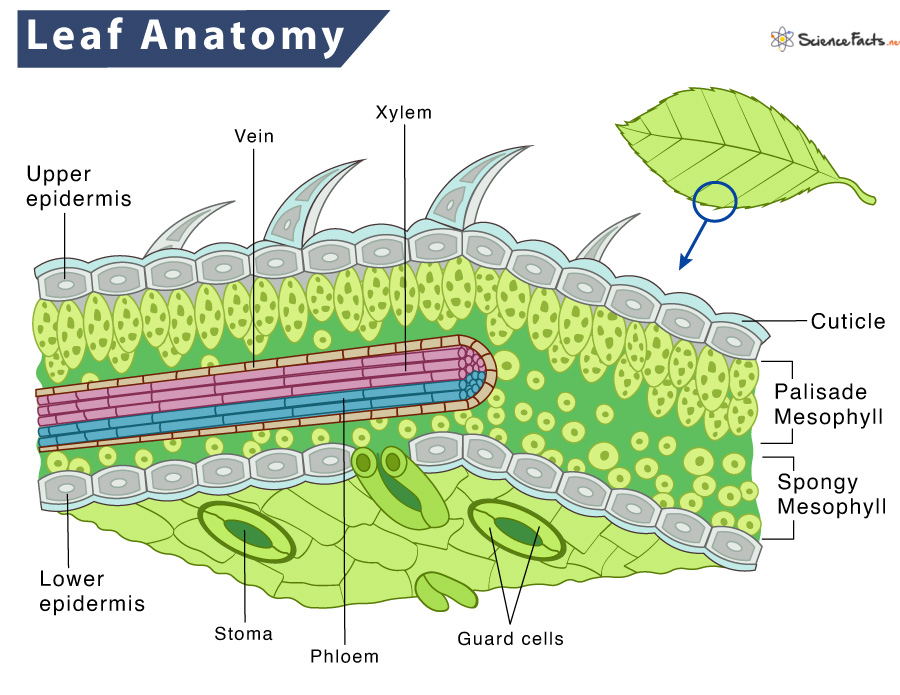Leaf Anatomy (Structure)
Leaves are complex organs consisting of several layers serving various essential functions. They are the site of photosynthesis in plants, producing food. For cellular functions like photosynthesis and respiration, leaves require several cells and tissues to work in coordination.
Different plant cell types form three main types of tissues in leaves. They are:
1. Epidermis – The leaf’s outer (above and below) layer.
2. Mesophyll – The inner layer sandwiched between two epidermis layers.
3. Vascular – Located within the mesophyll layer.
Let us now discuss the internal structure of a leaf in detail, specifically how the three cell types are arranged in a leaf in different layers along with its associated parts.
Layers of a Leaf
The different layers of a leaf include the cuticle layer, the upper epidermis, the palisade layer, the spongy layer, the lower epidermis, and the stomata. These structures work together to enable plants to perform their cellular processes, photosynthesis, respiration, and excretion.
Cuticle
It is the waxy layer of the leaf secreted by the epidermis, a thin layer of leaf present just below the cuticle. It performs the following functions:
- Preventing excessive water loss from the leaves through transpiration
- Controlling the exchange of gases such as dioxide and oxygen from the leaf surface
Giving mechanical support and thus preventing damage to the surface of the leaf against physical and chemical damage.
Upper Epidermis
It is a thin layer of cells below the cuticle. Mostly they are devoid of chloroplasts and thus do not perform photosynthesis. The upper epidermis performs the following functions:
- Preventing excessive water loss from the leaves through transpiration
- Allowing sunlight to pass through the spaces between the cells and thus helping to initiate photosynthesis in the underlying cells
- Regulating the exchange of oxygen and carbon dioxide
Palisade Mesophyll Layer
It is found just below the upper epidermis and is thus also called the upper leaf cells. They consist of columnar cells arranged vertically beside each other, much like the columns of a building. The columnar cells are tightly packed to maximize the absorption of sunlight. Sometimes it can consist of several layers of cells, particularly in environments with high amounts of sunlight.
As soon as sunlight passes through the epidermis, the chloroplasts within the cells start producing food by photosynthesis. The palisade layer performs the following functions:
- Performing the majority of leaf photosynthesis and thus in food production and cellular energy
- Helping to perform cellular respiration
Spongy Mesophyll Layer
This layer is found below the palisade layer. Also called the lower leaf cells, the spongy layer consists of irregularly shaped cells consisting of the vascular tissues – xylem and phloem, forming the vascular bundles. The vascular tissues are surrounded by parenchymal pith and collenchymas. The cells contain minute pores called stomata (Singular: stoma). The spongy layer performs the following functions:
- Facilitating the diffusion of nutrients and gases such as carbon dioxide, oxygen, and water through stomata
- Storing the products of photosynthesis such as carbohydrates and other organic molecules until they are required for use by other parts of the plant
- Transporting sap (water with nutrients) from the root to the leaf and food from the leaf to all other parts of the plant
Lower Epidermis
It is located on the bottom side of the leaves below the spongy mesophyll layer of cells. Stomata are essential structures in the lower epidermis. There may be up to one million stomata per square centimeter.
Each stoma is flanked by kidney-shaped epidermal cells called guard cells. The guard cells control the opening and closing of stoma based on the osmotic potential of the cell and its environment. The lower epidermis performs the following functions:
- Facilitating the majority of gas exchange in leaves
- Regulating loss of water by transpiration
FAQs
Ans. The structure of a leaf is specialized to trap sunlight and allow the exchange of gases such as intake of carbon dioxide and release of oxygen. They also contain vascular structures that help transport water from the roots into the cells. All the raw materials together help plants to perform photosynthesis.
-
References
Article was last reviewed on Friday, February 17, 2023




